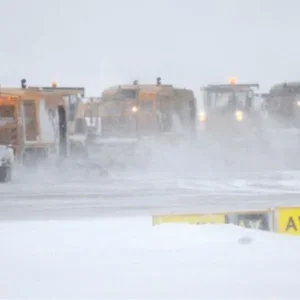Aviation meteorology (MET) is possibly the most important data stream for air traffic management (ATM) services given its impact on both safety and efficiency. Improving the integration of MET is a vital element of efforts to define tomorrow’s ATM services.
"MET is essential," says independent aviation meteorology consultant Dr Alan Hisscott. "Pilots need to know weather conditions for take-off, en route and at their destination airfield, as well as possible diversions. This basically ties in with ‘aerodrome’ and ‘en route’ ATM operations, so the two go hand in hand. Also, with the development and increasing reliance on satellite navigation, space weather is also becoming very important to aviation.
"The aviation industry is also becoming more environmentally conscious, and the price of fuel has also been driving more economical operations for many years, so forecasting upper-level winds have become essential to long haul operations, while accurate aerodrome forecasting is important to minimise costly diversions.
"An extreme example of the interaction of MET and ATM occurred during the eruption of Iceland’s Eyjafjallajökull in 2010, when MET dispersion forecasts were used by ATM services to define safe routes avoiding the ash cloud," he adds.
Current forecasting techniques
Ultimately, the goal is to have seamless connectivity between weather data inputs and operational decision-making systems. The integration of MET into the global model for ATM services that aviation authorities are continuously developing is, however, a major challenge.
For aerodrome operations, observations of current weather are currently provided to the ATC unit in terms of hourly or half-hourly reports. These are augmented by special reports if conditions change significantly for better or worse and affect key parameters such as visibility or cloud base inbetween the routine reports. However, in many cases, weather observations are now completed by ATC personnel who have undergone MET training rather than by a specialist aviation meteorologist.
Predictions regarding weather conditions are provided in TREND forecasts that cover the immediate two hours and terminal aerodrome forecasts (TAF), which typically cover a period of nine, 24 or 30 hours. MET services also provide warnings of specific adverse weather conditions such as ice, snow, strong winds and gales to ATM services, airlines and other airport users.
For the ‘en route’ segment of flights, graphical forecasts of significant weather such as areas of active thunderstorms or clear air turbulence, alongside details of upper winds at various flight levels, are provided on a regional basis by World Area Forecast Centres (WAFCs) located in Washington in the US and at the UK Met Office in Exeter. Additionally, for trans-Atlantic flights, specific tracks are defined twice daily by ‘way-points’ to enable aircraft to avoid the extremely strong headwinds associated with jet streams, and conversely benefit from strong tailwinds in the opposite direction in order to optimise fuel economy.
"There are already steps towards improving the provision of ‘en route’ wind information by MET services providing global numerical model data direct to airlines and operators," notes Hisscott. "Such data could well be incorporated into the International Civil Aviation Organisation’s (ICAO) developing global ATM strategy, especially as fuel prices continue to rise, more precise routing becomes possible with satellite navigation, and also in light of the ICAO’s environmental commitment to reducing aircraft emissions."
Winds of change
The paradigm for global ATM services evolves in line with technological and procedural advances. The ICAO recognises that there is a gap between the MET provisions stipulated in today’s ‘Annex 3 – Meteorological Service for International Air Navigation’ and the future requirements of ATM users.
MET information is delivered to most users in the form of coded METAR and SPECI reports of prevailing weather conditions, and TAF and TREND messages for forecast conditions, although some larger operators do receive ‘raw’ forecast data direct from the MET centres.
"Coded messages are broadcast at fixed times, so for METARs, for example, during periods of clearing fog at the destination airfield, operators can waste time waiting for updated reports," says Hisscott. "With modern communication, it seems likely that the ‘broadcast’ mode should move towards an ‘interrogation’ mode where ‘real-time’ weather conditions can be requested for specific aerodromes and delivered on demand.
"Specifically for ATM, with the increasing reliance on numerical modelling for forecasting conditions on a global and regional scale, and increasing computer power, it is technically possible to ’embed’ a very high-resolution forecast domain for a control zone or even an aerodrome environment into a larger-scale forecast model to obtain detailed, site-specific forecasts," he continues. "Such a development could provide a forecast evolution of very detailed local conditions and a vertical wind profile for an aerodrome or CTZ.
"This would be advantageous for optimising the ‘continuous climb’ and ‘continuous descent’ operations envisaged as part of the ICAO’s global ATM strategy."
The ICAO’s Annex 3 regulates the basic provisions for aviation meteorology and has to balance the needs of general aviation (GA), developing countries with budget and technological constraints, and high-tech global operators.
"GA is, in many countries, the source of most aircraft movements but most GA aircraft have very limited avionics," remarks Hisscott. "Also, many airfields used by GA have very limited facilities. However, it is the smaller number of high-capacity aircraft movements using major airports that generate most of the revenue for airports, ATM service providers and indeed the ICAO itself.
"So, perhaps we need to develop two versions of Annex 3, one very much like the current document, the other to regulate the high-technology sector, where large commercial operators and manufactures could press on with developing a framework for new ways of delivering MET services.
"It is also very important to integrate MET into decision-support tools, especially as fuel economy and environmental emissions become ever more important to airlines, operators and ATM services. MET forecast information is already incorporated into ‘en route’ decision-making and at an aerodrome level to minimise costly ‘go-arounds’ or diversions," he adds.
"The ICAO has stated that it is already working towards the integration, through block upgrades of a system-wide information system (SWIM) in support of collaborative decision-making (CDM). This will enable ATM managers and planners, pilots and operators to share information, including MET data, to enable improved safety, capacity and efficiency."
The drive to harmonise ATM is set to dominate the aviation agenda, and the closer integration of MET will no doubt be one of the most pressing issues.






